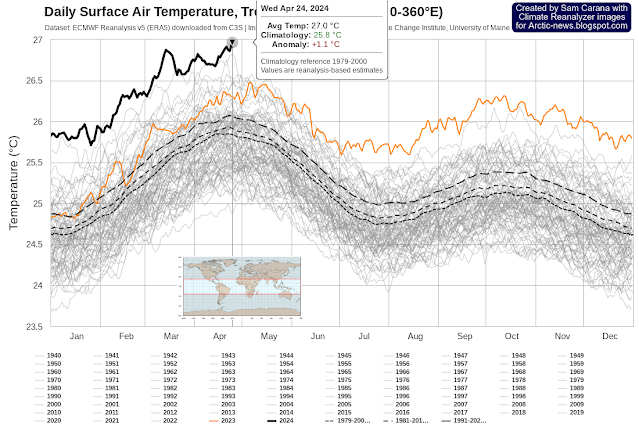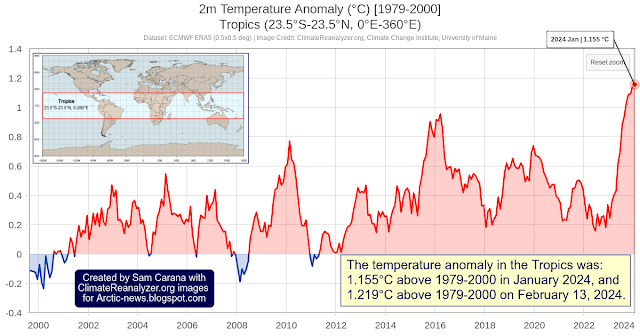The above image shows that on May 24, 2024, the temperature was 26.7°C (or 80.06°F), an anomaly of 1°C (or 1.8°F) compared to 1979-2000.
The image below shows the average monthly temperature anomaly over the past few years through April 2024, when the anomaly was 1.327°C (or 2.389°F) compared to 1951-1980.
Note that the above-mentioned anomalies are compared to 1979-2000 and 1951-1980, neither of which is pre-industrial. The anomalies would be much higher when calculated from a pre-industrial base.
The maps below are adapted from Climate Reanalyzer and show maximum temperatures for three days. The image directly below shows maximum temperatures on May 29, 2024. Extremely high temperatures were recorded in India and Pakistan.
The image below has a focus on Asia, showing the extremely high temperatures recorded in India and Pakistan on May 30, 2024.
The image below shows maximum temperatures around the world on May 31, 2024.
Surface precipitable water
Surface precipitable water reached a record high of 27.139 kg/m² in July 2023. Worryingly, data for the first four months of 2024 are a lot higher than they were in 2023 at the same time of year, as illustrated by the image below, adapted from NOAA. This raises fears that surface precipitable water will reach an even higher peak in 2024 than was reached in 2023.
Climate Emergency Declaration
The situation is dire and the precautionary principle calls for rapid, comprehensive and effective action to reduce the damage and to improve the situation, as described in this 2022 post, where needed in combination with a Climate Emergency Declaration, as discussed at this group.
Links
• Climate Reanalyzer
https://climatereanalyzer.org
• NOAA - Physical Sciences Laboratory
https://psl.noaa.gov
• Pre-industrial
https://arctic-news.blogspot.com/p/pre-industrial.html
The situation is dire and the precautionary principle calls for rapid, comprehensive and effective action to reduce the damage and to improve the situation, as described in this 2022 post, where needed in combination with a Climate Emergency Declaration, as discussed at this group.
Links
• Climate Reanalyzer
https://climatereanalyzer.org
• NOAA - Physical Sciences Laboratory
https://psl.noaa.gov
• Pre-industrial
https://arctic-news.blogspot.com/p/pre-industrial.html
• Temperature rise may soon accelerate even more
https://arctic-news.blogspot.com/2024/05/temperature-rise-may-soon-accelerate-even-more.html
• Atlantic ocean heat threatens to unleash methane eruptions
https://arctic-news.blogspot.com/2024/03/atlantic-ocean-heat-threatens-to-unleash-methane-eruptions.html
https://arctic-news.blogspot.com/2024/05/temperature-rise-may-soon-accelerate-even-more.html
• Atlantic ocean heat threatens to unleash methane eruptions
https://arctic-news.blogspot.com/2024/03/atlantic-ocean-heat-threatens-to-unleash-methane-eruptions.html
• Climate Plan
https://arctic-news.blogspot.com/p/climateplan.html
• Transforming Society
https://arctic-news.blogspot.com/2022/10/transforming-society.html
• Climate Emergency Declaration
https://arctic-news.blogspot.com/p/climate-emergency-declaration.html
Posts discussing Temperatures in the Tropics in 2024 at facebook are at:
https://arctic-news.blogspot.com/p/climateplan.html
• Transforming Society
https://arctic-news.blogspot.com/2022/10/transforming-society.html
• Climate Emergency Declaration
https://arctic-news.blogspot.com/p/climate-emergency-declaration.html
Posts discussing Temperatures in the Tropics in 2024 at facebook are at:
https://www.facebook.com/SamCarana/posts/10169104508720161 (update 6: May 11, 2024)
https://www.facebook.com/SamCarana/posts/10169053955465161 (update 5: Apr 24, 2024)
https://www.facebook.com/SamCarana/posts/10169050918525161 (update 4: Apr 23, 2024)
https://www.facebook.com/SamCarana/posts/10169042787710161 (update 3: Apr 20, 2024)
https://www.facebook.com/SamCarana/posts/10168930859815161 (update 2: Mar 12, 2024)
https://www.facebook.com/SamCarana/posts/10168929028460161 (update 1: Mar 11, 2024)
https://www.facebook.com/SamCarana/posts/10168860099940161 (update: Feb 14, 2024)
https://www.facebook.com/SamCarana/posts/10168858418170161 (Feb 13, 2024)
https://www.facebook.com/SamCarana/posts/10168795048860161 (Jan 22, 2024)
https://www.facebook.com/SamCarana/posts/10168858418170161 (Feb 13, 2024)
https://www.facebook.com/SamCarana/posts/10168795048860161 (Jan 22, 2024)





















